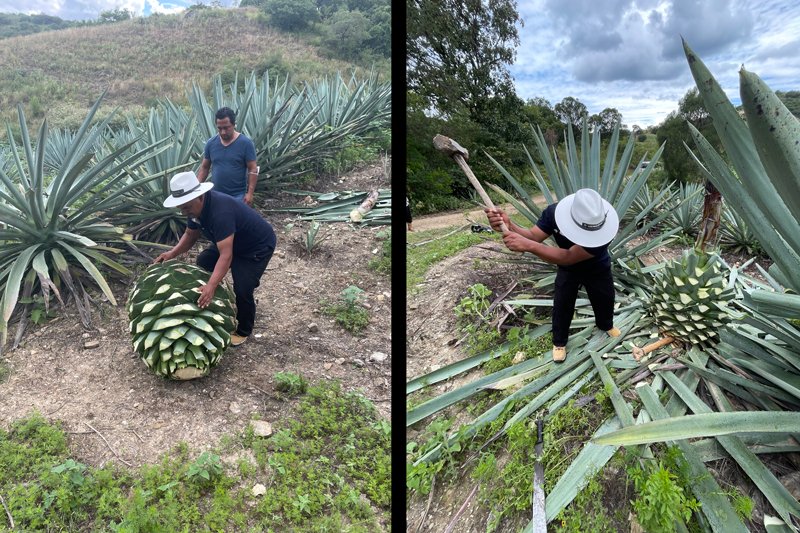
The Craft
From seed to soil to still, Eléctrico's Maestro Cirino has fine-tuned every aspect of the mezcalero art to protect the land, preserve the traditions, and perfect the product.

Agave, maguay or mexcalmetl
Stage 1
It starts with maguey (agave), or as the Zapotec people of Oaxaca say, mexcalmetl. We use the word "maguey" on our labels.
Dozens of maguey varieties grow in Mexico. Each variety has unique characteristics influenced by the region's climate, soil composition, and specific production methods. The most commonly used maguey for mezcal is Espadín.
For Eléctrico Mezcal, we currently distill three varieties of maguey: Espadín, Tobalá, and Jabalí. Espadín is the fastest-growing (7-8 years), easiest-to-cultivate maguey with the highest sugar content. A single piña (heart) can weigh over 500 pounds, of which over a third can be sugar.
Tobalá is a medium-sized, slow-growing (12-year) wild maguey with a lower sugar content but a complex and seductive flavor. Jabalí grows wild and widely in Oaxaca. It has a very low yield and takes 15-20 years to be ready to harvest. Not many palenques distill it.
We plan to offer other maguey as "special" distillations.
Harvest / Jima
Stage 2
The way we source our maguey depends on the variety of plant and the season. We cultivate much of our Espadín on small fields in the surrounding hills. We also buy from trusted neighbors who never use chemical growing aids.
Maestro Cirino knows exactly when a plant is ripe for harvest, though the sugar content can vary widely depending on the season—more rain means less sugar.
The long, spiny leaves, are cut away with a macheté, and the heart, the piña, is sliced free with a coa jima, a hand-wrought harvesting hoe.
Our tobalá and jabalí are harvested from the wild, sourced from the moutains around San Baltazar, which we reseed during the rainy season.

The Cook / Cocinar
Stage 3
The quality of the cook, the three-day roasting of the piñas, is critical to the flavor of Eléctrico Mezcal. The oven, the horno, is a large stone-lined pit at the palenque that can hold up to six tons of piñas. The great cone of embers, stones, piñas, sacks, and soil built in the horno must remain untouched for 72 hours. So, controlling the cook is a finely honed skill. A failed cook can prove very expensive with such great quantities at stake.
We use only hard, slow-burning, bone-dry, dead oak for our cook. The steady heat it radiates through the stones ensures the maguey softens and concentrates the aguamiel, the honey water in the piñas, without over-infusing it with smoke.
Too much smoke in your mezcal smothers the subtleties of the spirit. It’s also the best way to a headache.
The Mill / Tahona
Stage 4
In lesser mezcals, the milling of the roasted piñas is often sidestepped with the use of a woodchipper. Master Cirino can taste the woodchipper in the mezcal flavor and would rather take his time the traditional way.
We use a traditional tahona, a heavy stone millwheel pulled by our faithful horse Marfil, to slowly crush the piñas into a sweet, fibrous, syrupy must.
Marfil is a family member, and when she says she doesn’t want to work anymore, we stop working. It may not be efficient, but we wait years to sip our mezcal and wouldn’t begrudge Marfil a little relaxation when she wants it—not that we’d have a say anyway.

Fermentation
Stage 5
Only the natural yeasts in the mountain air of San Baltazar Guelavila act as a starter for our freshly milled must. We add nothing but gently warmed artesian spring water. Within an hour, a thick layer of chocolate-colored espuma covers the sweet liquid and pulp in our 1500-liter pine times. The fermentation process has begun.
Three to five days later, depending on the weather, Master Cirino uses only his sense of smell to determine whether the fermented wort, the tepache, is ready for the still.
Distillation
Stage 6
We treasure the Eléctrico Alambique stills. They are made of the purest copper to avoid tainting the mezcal. They are set in concrete over wood-burning fires, and their condensing coils are immersed in tanks of cold spring water.
The first distillation is messy. The still is filled with aguamiel and bagasse, the fibrous pulp remaining from the fermentation. Some remove this, but it is full of flavor. The liquid evaporates upwards, passing through copper pipes and condensing again in the cold water, emerging as a steady trickle of crystal-clear distillate.
The resulting fluid is collected in three stages: the punta, or head; the ordinary, or body; and the cola, or tail. Relatively low in alcohol, the punta is set aside while the ordinary and cola are placed back in the empty still for a second pass.
What emerges is almost pure alcohol, far too potent for consumption. Many mezcals are quite literally watered down. We temper our APV% with the punta from the first distillation, enhancing the flavor while reducing the alcohol content below half.
Cirino is a master at judging alcohol content by eye. He siphons mezcal into a valencia, a short cane with a fine hole drilled through its center, and releases it into a small bowl. The stream of bubbles or pearls this creates, and the time they remain intact, tells him whether there is too much or too little alcohol. He is rarely out by more than one or two percent.
Bottling or maturing
Stage 7
Unlike many spirits, mezcal can be sipped straight from the final distillation. Our Joven mezcals are delicious straight out of the pipe, but we keep them for a few weeks to let the flavors mingle and settle before bottling and labeling them on-site.
About 10 percent of our output is stored in glass carboys away from the sun and within a specific temperature range for at least three years. It is most definitely worth the wait.












